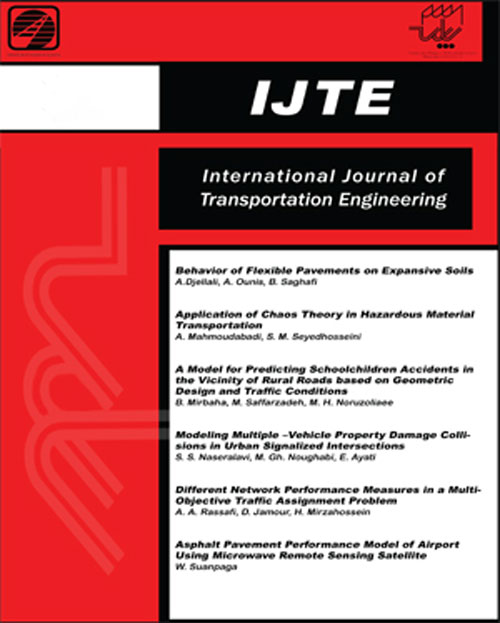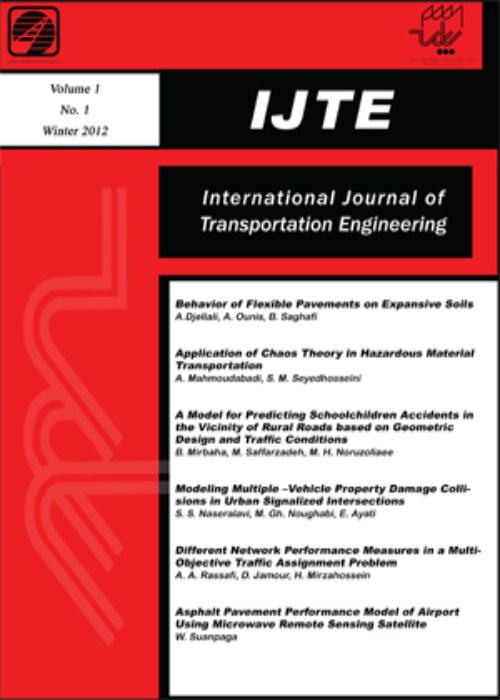فهرست مطالب

International Journal of Transportation Engineering
Volume:5 Issue: 1, Summer 2017
- تاریخ انتشار: 1395/12/01
- تعداد عناوین: 6
-
-
Pages 1-16Resilient modulus of pavement materials is a key property required for the pavement thickness design. This paper describes the results of an experimental study on the effects of temperature and loading frequency on the resilient modulus of a SBS polymer modified asphalt concrete under dry and saturated conditions. Dynamic creep tests were conducted on dry and saturated specimens of the mixture over a range of temperatures (-5, 5, 20 and 40˚C) and loading frequencies of 0.5, 1, 5 and 10Hz, and the variation of resilient modulus with the number of loading cycles has been evaluated. The results show that, in dry condition, the resilient modulus increases with increasing loading frequency, while, in saturated condition, a slight increase of resilient modulus with loading frequency was observed only at 40˚C. It is also found that, in both the dry and saturated conditions, the effect of loading frequency on the resilient modulus decreases with decreasing temperature. Therefore, the temperature of 40˚C was recommended for investigating the effect of loading frequency on the resilient modulus. In addition, a three-stage model was used for the resilient modulus. It is found that the logarithmic function is more appropriate for prediction of resilient modulus in stage 1.Keywords: SBS polymer, resilient modulus, asphalt concrete, moisture damage
-
Pages 17-29Initial cracks occur in high strength concrete sleepers for various reasons, such as shrinkage and wrong curing and long lifetime of over 50 years of sleepers. These cracks may lead to complete failure of the structure. In order to more accurately design the sleepers, fracture mechanics (not strength of materials) should be incorporated. In order to achieve this purpose, it is important to forecast crack growth and residual strength reduction rate. In this study, based on the principles of nonlinear fracture mechanics (NLFM) in concrete material, fracture behavior of pre-stressed concrete sleepers was investigated. Sleepers with the lengths of initiation crack of 5 mm with 10 mm step increasing to 45 mm were tested. Five specimens in each group were loaded under three-point bending test, in order to calculate Ic K , crack growth, and load-displacement diagram. The results showed that by increasing the crack-to-depth ratio, initial toughness, crack stability, and crack unstable toughness, the crack instability expansion begins. By increasing the crack-to-depth ratio, both initial and unstable toughness values increased linearly versus LEFM theory. Damage begins with an initial crack like in flexural damage and then continues with bifurcation of the crack. The influence of shear damage in sleeper's crack growing leads it to the ultimate damage.Keywords: Fracture mechanics, damage mechanics, pre-stressed concrete sleeper b70, stress intensity factor, crack-to-depth ratios
-
Pages 31-44Significant advantages of intermodal and containerized transport have increased the global interest to this mode of transportation. This growing interest is reflected in the annual volume of container cargo growth. However, the container transport inside Iran does not have a proper place. Comparing the count of containers entering and leaving ports with the statistics obtained from railway and road maintenance organizations showed that more than 77% of the containerized imports have been stripped at ports and dispatched toward their ultimate destinations outside containers. These statistics also showed that more than 81% of the containerized exports have transported to ports by means other than containers. The main purpose of this study was to identify the most important variables affecting the selection of containerized freight transport and non-containerized freight transport options by applying decision tree models on the road freight movement and a set of variables describes the differences between these two options. The final model representing the selection of containerized transport was developed by the use of CHAID, QUEST, C5 and C$R decision tree algorithms. The results showed that the decision tree built via pruned C5 algorithm provides the best accuracy and most sensible list of important parameters. High-value and perishable commodities showed the greatest potential for containerized transport. The most important policy factors that could affect the tendency of cargo owners to use containerized transport are tariffs and the status of destination (whether it is a port). Policies that could encourage cargo owners to use intermodal transport include setting a lower tariff on container handling, reducing the cost of loading and unloading, increasing the port facilities supporting the containerized transport, adjusting customs, and development of dry ports.Keywords: Container, freight transport, decision tree, port, tariff
-
Pages 45-58In this study, unconfined compression tests have been conducted to investigate the impacts of copper slag on mechanical characteristics for stabilized cement and un-stabilized soil. Dozens of specimens were prepared at four percentages of cement (i.e. 0%, 2%, 4% and 6%) and five percentages of copper slag (i.e. 0%, 5%, 10%, 15% and 20%) by weight of dry soil. The samples compacted into a cylindrical specimen and processed for the curing periods of 28, 60 and 90 days. The test results indicated that the inclusion of copper slag had a significant effect on the unconfined compressive strength (UCS). For cement stabilized specimens, the improvement impacts of the copper slag on the UCS was more tangible than un-stabilized ones. Furthermore, an increase in the UCS was most apparent in the 2% cemented specimen wherein the UCS increased more than 78% as the copper slag increased up to 20%. Moreover, it was evident that the more amount of copper slag increased, the more optimum moisture content (OMD) declined and additionally maximum dry density (MDD) of soil was on the rise, while the results of the increase in cement was quite the reverse. Moreover, an artificial neural network (ANN) model has been developed using eight input parameters including: copper slag content, cement content, water content, dry density, liquid limit, plastic limit, PH and curing age. An ANN network, composed of 10 neurons in a hidden layer, was considered as the appropriate architecture for predicting the elastic modulus of mixtures, and an excellent conformity was acquired between the observed test data and the predicted ones. The results was proven that the proposed model can be efficiently applied to predict the elastic modulus of stabilized soils.Keywords: Copper slag, Cement stabilization, Unconfined compressive strength, Elastic modulus, Artificial neural network
-
Pages 59-85Location-Routing Problem (LRP) emerges as one of the hybrid optimization problems in distribution networks in which, total cost of the system would be reduced significantly by simultaneous optimization of locating a set of facilities among candidate locations and routing vehicles. In this paper, a mixed integer linear programming model is presented for a two-echelon location-routing problem with simultaneous pickup and delivery. In the investigated problem, one echelon of facilities, which is called the middle depot echelon, is positioned between central distribution centers and customers echelons. The number and capacity of middle depots and vehicles are considered to be limited. Besides, each network customer demands for both receiving a type of commodities and delivering another type to vehicles to be returned to the depot. In the literature of location routing problem, the majority of researches have been conducted in the deterministic conditions. However, we present a model in which data uncertainty is also taken into account and customer's demand is assumed to be a fuzzy parameter. We utilize a fuzzy programming approach to cope with uncertain demands. Moreover, a combined heuristic method based on simulated annealing (SA) algorithm and genetic algorithm (GA) is devised for solving the presented model. The results achieved from solving the problem in different sizes of numerical examples imply that the proposed hybrid algorithm outperforms other algorithms within reasonable length of time. The effectiveness of the proposed solution method is examined through a comprehensive numerical experiments. Finally, valuable insights are provided via conducting a number of sensitivity analyses.Keywords: Location-routing problem, Two echelons, Fuzzy numbers, Credibility theory, Hybrid algorithm
-
Pages 87-101Motorcycle crashes constitute a significant proportion of traffic accidents all over the world. The aim of this paper was to examine the motorcycle crash patterns and rider fault status across the provinces of Iran. For this purpose, 6638 motorcycle crashes occurred in Iran through 2009-2012 were used as the analysis data and a two-step clustering approach was adopted as the analysis framework. Firstly, hierarchical clustering (HC) was applied to group the provinces into homogenous clusters, based on the distribution of crash characteristics in each province. In the second step, the latent class clustering (LCC) was employed to investigate the crash patterns and rider fault status among the provinces. The provincial groupings were found to be an influential factor in the final crash clusters implying the effectiveness of the proposed framework. Results of LCC also indicated that Cluster 8 with the highest percentages of not wearing helmet, unlicensed and under 21 years old riders, had the highest percentage of fatal crashes. In addition, the motorcyclists seemed to be less responsible in the pedestrian-motorcycle crashes. Accordingly, training programs for the riders in the license issuance process about the risk of pedestrian-motorcycle crashes could help mitigate this type of crashes. Generally, analyzing the culpability in pedestrian-motorcycle crashes might be a good topic for future research. Further discussions on the crash patterns are provided. Finally, the combined use of HC and LCC should not be regarded as an alternative to the other more qualitative predictive methods, but as a preliminary analysis tool to provide insights over the road safety condition at the national level.Keywords: Hierarchical clustering, Latent class clustering, Motorcycle crashes, Motorcyclist's fault status


